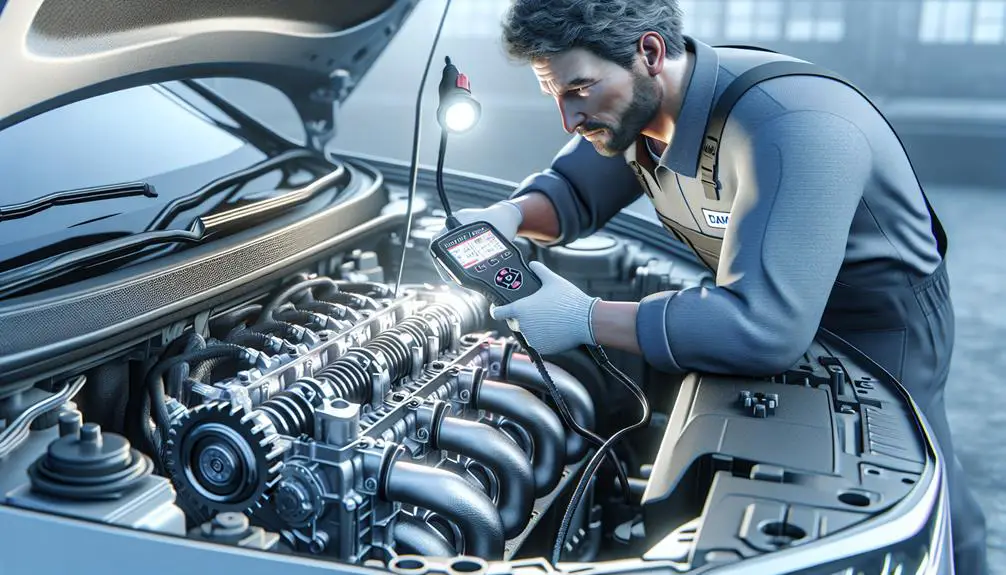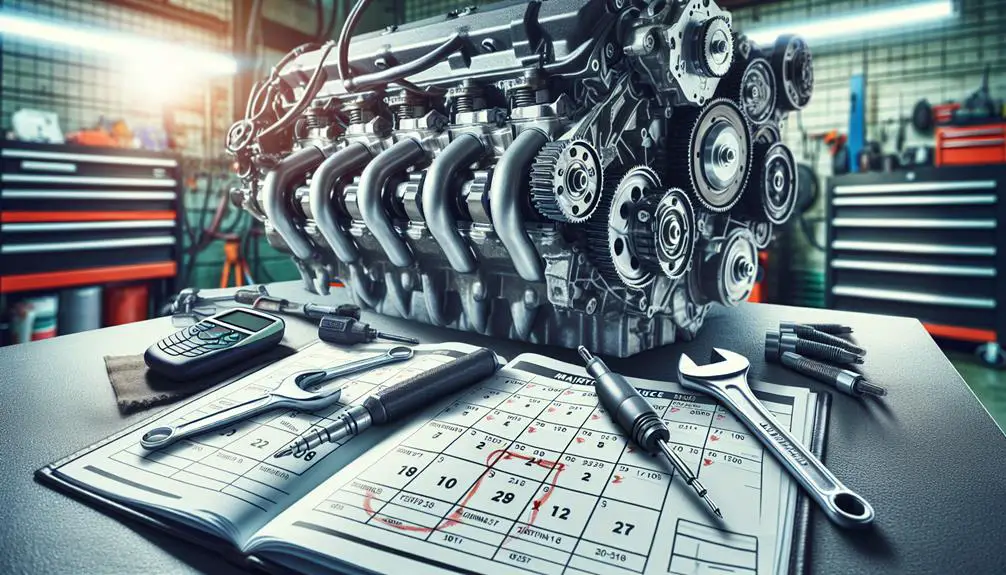Hyundai Accent's engine performance issues are often due to camshaft position sensor problems.
These issues can lead to symptoms such as rough idling, stalling, or difficulty starting the vehicle.
A malfunctioning camshaft position sensor can disrupt the engine's timing, leading to poor performance and decreased fuel efficiency.
Common Symptoms

If your Hyundai Accent begins to exhibit erratic performance, it's likely a sign of camshaft position sensor issues. You'll notice your car's engine might start to stall or experience difficulty starting. This happens dance the sensor, which plays a vital role in managing the engine's timing, isn't sending the right information to the engine control module. You're essentially driving blind without the proper guidance that your engine desperately needs to function smoothly.
Another telltale symptom you might encounter is poor fuel economy. If you're finding yourself at the pump more often than usual, it's worth considering a check-up for the sensor. It's not just about the inconvenience or the added expense; it's a sign that your car isn't running as efficiently as it should be.
Additionally, you might notice your car idling roughly or even misfiring. These symptoms can range from mildly annoying to downright dangerous, especially if you're in traffic. It's unsettling when you press the gas pedal, and instead of a smooth acceleration, you get a stutter or a jolt. These are clear indicators that it's time to address the problem, ensuring your safety and the essential performance of your Hyundai Accent.
Potential Causes
Grasping the symptoms of a faulty camshaft position sensor in your Hyundai Accent naturally leads to questioning what causes these issues in the beginning. You're right to wonder, as comprehending these causes can help prevent future occurrences. Let's delve into the potential reasons your sensor might be acting up.
| Cause | Explanation |
|---|---|
| Wear and Tear | Normal aging and use can degrade the sensor's effectiveness. |
| Electrical Issues | Short circuits or corroded wires can impair sensor function. |
| Dirty Sensor | Accumulation of oil and grime can obstruct its accuracy. |
| Installation Errors | Improper installation may lead to early failure. |
| Timing Belt Problems | Misalignment can cause incorrect readings. |
You're likely dealing with one of these issues if you've noticed any of the symptoms mentioned previously. Each cause has its unique pathway to affecting your Accent's performance, but they all share the potential to disrupt your vehicle's operation significantly. Ignoring these signs can lead to more severe problems down the line, so it's essential to address them promptly. Remember, this isn't about blaming the car; it's about comprehending it better to assure a smoother ride.
Diagnostic Steps

To accurately diagnose a faulty camshaft position sensor in your Hyundai Accent, you'll initially need to gather a few tools and prepare your vehicle for testing.
Initially, make sure your car is on level ground and the engine is cool. You'll need a diagnostic scanner, a multimeter, and basic hand tools. Connect the diagnostic scanner to your car's OBD-II port. This port is typically located under the dashboard, near the steering column. Turn on the scanner and your vehicle's ignition, but don't start the engine. Look for any diagnostic trouble codes (DTCs) related to the camshaft position sensor. These codes can guide you towards the issue.
Next, locate the camshaft position sensor. It's usually found at the front of the engine, near the top. Consult your vehicle's manual for the exact location. Using your multimeter, check the sensor's voltage and ground connections. The readings should match the specifications in your Hyundai's service manual. If the voltage is erratic or the ground connection is poor, it's a sign the sensor might be failing.
Repair and Replacement
Once you've diagnosed a faulty camshaft position sensor in your Hyundai Accent, it's time to tackle the repair or replacement process. This step is important not only to restore your car's performance but also to guarantee its safety on the road. While it might seem intimidating, with the right tools and a bit of patience, you can handle this task yourself.
Here's a simplified breakdown of the steps you'll need to follow:
- Disconnect the battery: Always start by disconnecting your car's battery to guarantee safety.
- Locate the sensor: The camshaft position sensor is usually found near the top of the engine. Consult your car's manual for the exact location.
- Remove the faulty sensor: Carefully disconnect the sensor's wiring harness and unscrew it from its position.
- Install the new sensor: Screw the new sensor in place, and reconnect the wiring harness.
- Reconnect the battery and test: After installation, reconnect your battery and start your car to make sure the new sensor is functioning properly.
Preventive Measures

You can extend the life of your Hyundai Accent's camshaft position sensor with regular maintenance and by being mindful of warning signs. Keeping your vehicle in top condition isn't just about addressing issues as they arise; it's also about preventing them before they start. Here's how you can stay ahead of potential camshaft position sensor problems:
| Maintenance Task | Frequency | Benefit |
|---|---|---|
| Check Engine Oil Level | Every 1,000 miles | Ensures proper lubrication |
| Inspect Wiring Harness | Every 10,000 miles | Prevents electrical issues |
| Replace Timing Belt | As per manual | Keeps engine timing in sync |
| Diagnostic Scan | Annually | Identifies early fault signs |
To begin with, make sure you're checking your engine oil level regularly. Low oil levels can lead to increased wear and tear, affecting the camshaft position sensor indirectly. Next, inspect the wiring harness connected to the sensor for any signs of wear or damage; this can prevent electrical faults that might cause sensor malfunctions. In addition, replacing the timing belt according to your Hyundai's service manual recommendations is important; a worn timing belt can throw off engine timing, affecting the sensor's readings. Lastly, consider getting a diagnostic scan of your vehicle annually to catch any early signs of trouble. By staying proactive, you'll save yourself time and money down the line.
Conclusion
To sum up, if you're facing issues with your Hyundai Accent's camshaft position sensor, you'll likely notice tell-tale signs like rough idling or trouble starting your car. Several factors, including wear and tear or electrical faults, could be to blame.
To pinpoint the problem, running a diagnostic is important. Once identified, replacing the sensor is typically straightforward.
To avoid future hassles, regular vehicle maintenance and addressing any electrical system anomalies early can save you a lot of trouble down the road.